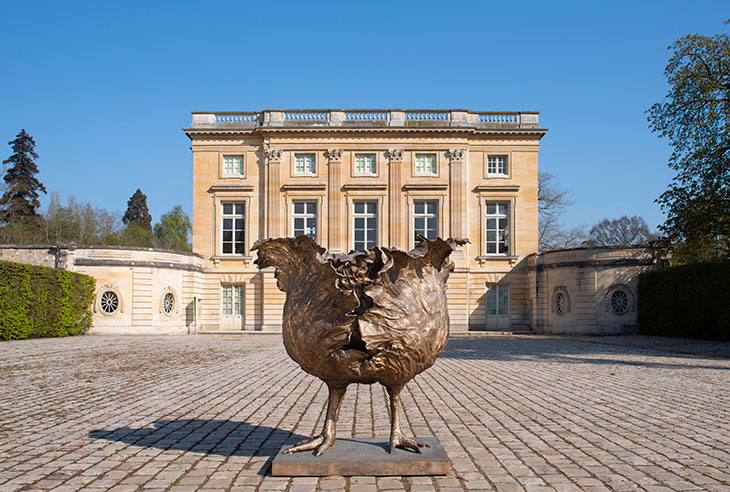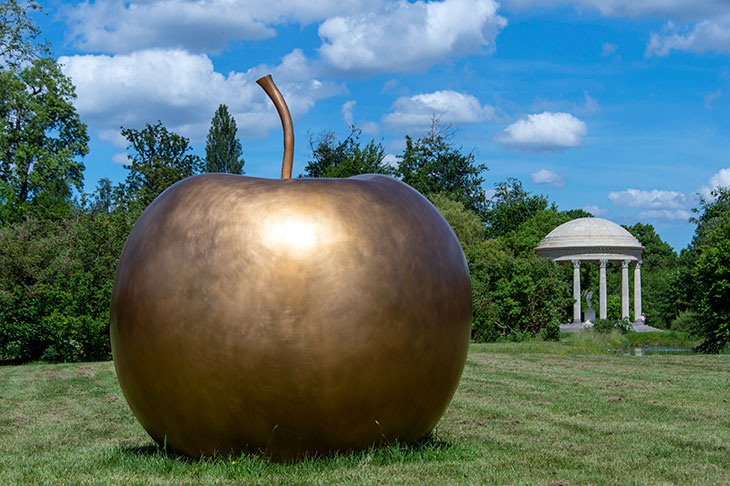‘The interesting thing,’ says Jean-Gabriel Mitterrand, ‘is that when you use a Lalanne desk, bar or chair, you have to change the way you use a desk, bar or chair.’ To demonstrate his point, the Parisian art dealer shifts left and right on the seat of Claude Lalanne’s Banquette Crocodile (2006). ‘I can’t sit on this banquette as I normally would. I have to search for a comfortable position, and one that shows the crocodile.’ He gestures to one of two gilt-bronze reptiles, snouts almost touching, their tails wrapped around the edge of the banquette and their scaly bodies forming its back. Sitting opposite in a matching armchair, I too begin to fidget, conscious all of a sudden of a claw close by my elbow.
We’re in the French Pavilion, a rococo structure in the Estate of Trianon at Versailles, west of Paris. Large windows overlook the neatly manicured French gardens and the neoclassical Petit Trianon palace beyond; nearby are the less formal English gardens and the rustic Queen’s Hamlet. Construction on the estate primarily took place during the reigns of Louis XV and Louis XVI, whose wife, Marie Antoinette, sought refuge from the stuffy confines of court life in the bucolic surroundings and quickly made them her own. Snaking through the grounds this summer is a sculpture trail of more than 50 works by François-Xavier and Claude Lalanne, known together as Les Lalanne. Claude, who died in 2019 at the age of 93, and her husband, who died 11 years earlier, have been represented by Mitterrand’s gallery since the early 1990s.
This open-air show is free from signage, so visitors are left to chance upon the fantastical creations on tree-lined avenues and in grassy meadows and lakes. One of the first I encounter is François-Xavier’s L’Âne Attelé (1984), an astonishingly lifelike donkey and cart parked in the courtyard of the Petit Trianon. Claude’s Pomme de New York (2006), a freshly buffed golden apple, sits on a tidy lawn as if it’s fallen from the branch of a golden tree. On the way to the Belvédère, an octagonal folly completed in 1781, is her Choupatte (2016), a bronze cabbage standing on chicken legs, and inside is François-Xavier’s Lit Cocodoll (1964), a dreamy bed shaped like a seagull.

Choupatte (2016), Claude Lalanne. Photo: Capucine de Chabaneix; courtesy Galerie Mitterrand; © Claude Lalanne
From the beginning of their partnership Les Lalanne, who met in 1952 and married fifteen years later, bridged the gap between sculpture and decorative art. Though they built their brand as a couple, for the most part they stuck to separate studios. They shared a fondness for nature – François-Xavier focused mostly on animals, Claude on botanical forms – but each had a distinctive style. Following in the classical tradition of Poussin, Ingres and Matisse, François-Xavier favoured pure lines, keen to capture an animal’s expression and movement with minimum detail. Claude’s work is more ornamental and baroque. ‘She was in a way the contrary of François-Xavier,’ says Mitterrand. ‘While he began with drawing, she began with all the materials she had in the studio.’ Through a 19th-century process called galvanoplastie, or electroplating, she transformed nature into art – immersing flora and fauna in a bath of copper sulphate to create metal casts of the organic matter.
Together with Laurent Salomé, director of the National Museum of the Palace of Versailles and Trianon, Mitterrand carefully considered where to position each work. Both familiar and lesser-known sculptures dot the grounds, which are intimate and varied and a better fit for Les Lalanne than the stately surrounds of the main Château de Versailles. In the French gardens, formerly home to exotic plants and animals beloved by the kings, can be found a seated gorilla and a steel arch supported by two elephants. In the English gardens, wild boar stalk a deer, and a bear rises up on its hind legs. The Queen’s Hamlet, a fairy-tale-like model village built at the request of Marie Antoinette in the 1780s, is populated by a bronze rabbit with a staff and a pair of oversized turtle doves. ‘The sculptures suit the landscape, of course, but also the ideas and tastes of the 18th century,’ says Catherine Pégard, president of Versailles. ‘The spirit and sense of humour at the court, too.’

In the foreground, François-Xavier Lalannes’s Les nouveaux moutons, Bélier, Brebis et Agneau (1994–96); in the background, his Ane Bâté (1985) Photo: Capucine de Chabaneix; courtesy Galerie Mitterrand; © François-Xavier Lalanne
That sense of humour comes across in François-Xavier’s functional sculptures. Back in the French Pavilion is the Bar Autruches (1970), commissioned by Georges Pompidou for the Élysée Palace and made with the help of the Manufacture de Sèvres. One of only a handful of editions, and exceptionally fragile, it’s rarely been seen. Still, in theory drinks can be stored within the porcelain ostriches’ bodies, while the egg balancing on the counter extending between their beaks is meant for ice cubes. It’s both practical and playful. ‘Les Lalanne have a kind of surrealist humour,’ says Mitterrand. ‘They change the way we use art and how we live with it.’ They might also be said to change how we see the world around them: elsewhere, a bull with a large rectangular cut-out reframes a view.
The dialogue between the creations of Les Lalanne and the surrounding landscape is a delight. François-Xavier’s Carpe d’Or (1996) floats on the surface of the lake pooling out in front of the Belvédère, its golden glow reflected in the water and illuminating actual fish below. During my visit, a herd of his trademark stone-and-bronze sheep – which double as seats – are accompanied by a real-life flock of geese. While the geese are dozing, beaks tucked beneath wings, Les Nouveaux Moutons (1994) are alert, keeping watch as I approach.

Pomme de New York (2006), Claude Lalanne. Photo: © EPV/Didier Saulnier; courtesy the Château de Versailles and Galerie Mitterrand, Paris
A collaboration between Galerie Mitterrand and the Château de Versailles, the exhibition was planned in just three months. The palace usually hosts an exhibition by a living artist every year, but the current circumstances meant it was too expensive and difficult to realise. Mitterrand met with Pégard in March and floated the idea of showing Les Lalanne instead. Pégard asked if the show could be ready for the reopening of Versailles in June. Thanks to the co-operation of the four daughters of François-Xavier and Claude, who have lent roughly 70 per cent of the artworks on show, and a handful of other devoted collectors, it could. ‘This exhibition is quite different from those we’ve had in previous years,’ says Pégard. ‘It’s poetic and it takes on the spirit of Marie Antoinette and of the Trianon.’
That spirit shines through particularly in Les Lalanne’s more fanciful designs. Before I leave, I decide to take another turn around the French gardens. Lingering on the Petit Trianon’s western terrace is François-Xavier’s Lapin à Vent de Tourtour (1994), a beast with the body of a bird, hooved feet and a softly forked fishtail. It has a rabbit’s head that moves like a weathervane in the breeze, and as I pass by I’m sure I see it turn to follow me. The Estate of Trianon provided Marie Antoinette with an escape, and more than two centuries later the wonderful, whimsical sculptures of Les Lalanne offer us the same: they set the imagination free.
‘Les Lalanne at the Trianon’ is at the Château de Versailles until 10 October.














![Masterpiece [Re]discovery 2022. Photo: Ben Fisher Photography, courtesy of Masterpiece London](http://zephr.apollo-magazine.com/wp-content/uploads/2022/07/MPL2022_4263.jpg)
‘Like landscape, his objects seem to breathe’: Gordon Baldwin (1932–2025)